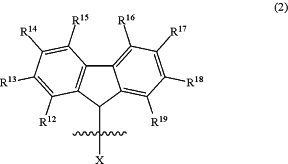| CPC C08F 4/80 (2013.01) [C08F 4/7031 (2013.01); C08F 110/02 (2013.01); C08F 210/02 (2013.01); C08F 218/02 (2013.01)] | 8 Claims |
|
1. A catalyst for olefin polymerization comprising a metal complex represented by formula (C1)
 wherein, in the formula, M represents an element of Group 10 of the Periodic Table; X represents a phosphorus atom (P) or an arsenic atom (As); R5 represents a substituent selected from the group consisting of a hydrogen atom, the group consisting of a halogen atom, a hydrocarbon group having 1 to 30 carbon atoms, a hydrocarbon group having 1 to 30 carbon atoms substituted with a halogen atom, a hydrocarbon group having 2 to 30 carbon atoms substituted with an alkoxy group having 1 to 10 carbon atoms, a hydrocarbon group having 7 to 30 carbon atoms substituted with an aryloxy group having 6 to 20 carbon atoms, a hydrocarbon group having 3 to 30 carbon atoms substituted with an amido group having 2 to 10 carbon atoms, an alkoxy group having 1 to 30 carbon atoms, an aryloxy group having 6 to 30 carbon atoms, and an acyloxy group having 2 to 10 carbon atoms; R6 and R7 each independently represent an alkoxy group, an aryloxy group, a silyl group, an amino group, or a hydrocarbon group having 1 to 180 carbon atoms which may be substituted with one or more groups selected from a halogen atom, an alkoxy group, and an aryloxy group, and at least one of R6 and R7 represents a 9-fluorenyl analogous group represented by formula (2)
 wherein, in the formula, R12, R13, R14, R15, R16, R17, R18 and R19 each independently represent a substituent selected from the group consisting of a hydrogen atom, a halogen atom, a hydrocarbon group having 1 to 10 carbon atoms, a hydrocarbon group having 1 to 10 carbon atoms substituted with a halogen atom, a hydrocarbon group having 2 to 20 carbon atoms substituted with an alkoxy group having 1 to 10 carbon atoms, a hydrocarbon group having 7 to 20 carbon atoms substituted with an aryloxy group having 6 to 10 carbon atoms, an alkoxy group having 1 to 10 carbon atoms, an aryloxy group having 6 to 10 carbon atoms, and an acyloxy group having 2 to 10 carbon atoms; and R12, R13, R14, R15, R16, R17, R18 and R19 may be bonded to each other to form a ring structure; wherein, in formula (2), a bond between a carbon atom and X in formula (C1) is depicted; R8, R9, R10 and R11 each independently represent a hydrogen atom, a halogen atom, a hydrocarbon group having 1 to 20 carbon atoms, an alkoxy group having 1 to 8 carbon atoms, an aryloxy group having 6 to 20 carbon atoms, a silyl group substituted with a hydrogen atom or a hydrocarbon group having 1 to 20 carbon atoms, or a hydrocarbon group having 1 to 20 carbon atoms substituted with a halogen atom; L represents an electron-donating ligand; and q is 0, ½, 1 or 2.
|